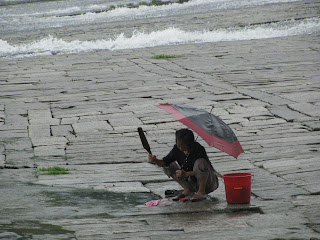It was raining cats and dogs when I woke up the next day. I felt more like sleeping in than doing anything. In the end, made a last minute decision to visit Shexian, a little town which is only half an hour away from Tunxi. This is actually a very small town, but is nonetheless very interesting. There are a few worthy sights and the first stop was a dam, where the lives of locals revolved around for years. Many people here still live in houses passed down from their ancestors, right by the dam, but they no longer fish for a living. Nowadays, fishing is more for tourists and leisure. 
.JPG)

.JPG)
.JPG)
.JPG)



.JPG)
 下一站是歙县的古城,这里的徽族建筑可算是保留得最完整的。就像在屯溪老街看到的建筑一样,这些房子屋顶的两角都是翘上来的,这就是徽族房子的特色。
下一站是歙县的古城,这里的徽族建筑可算是保留得最完整的。就像在屯溪老街看到的建筑一样,这些房子屋顶的两角都是翘上来的,这就是徽族房子的特色。Next up, is the old city of Shexian. Here is where you see one of the best preserved examples of the Hui people’s culture and architecture. Just like the buildings that you see in the Old Street of Tunxi, the buildings here all have roofs that curved up at the ends, a distinctive feature of the Hui people. .JPG)
.JPG)
.JPG)
.JPG) 在被重建的徽人旧村——徽园内,除了保留了徽族房子,房子里头还摆放了一般徽族人在家里会用的家具和日常用品。除了看到手工精致的雕刻品和日常用品外,还看到了完整的徽族女子的房间。有留意到床脚下的那个木制的壶吗?那个就是女主人放缠脚布的专用壶。
在被重建的徽人旧村——徽园内,除了保留了徽族房子,房子里头还摆放了一般徽族人在家里会用的家具和日常用品。除了看到手工精致的雕刻品和日常用品外,还看到了完整的徽族女子的房间。有留意到床脚下的那个木制的壶吗?那个就是女主人放缠脚布的专用壶。In Hui Yuan, a remade version of what a Hui village used to look like, you can see many Hui houses, complete with furniture and all the knick knacks you will see in a house. There are also fine examples of a typical Hui woman’s room. Notice the little wooden container at the foot of the bed? That is for the ladies to put the cloth binding their feet when they go to bed. The cover keeps the smell of the binding cloth contained. .JPG)

.JPG)
.JPG)

 古城内还保留了一个牌坊,这是一个叫许国的礼部尚书(相等于我们现在的教育部长)立的牌坊。根据导游的说法,从牌坊可以看得出这些人的家庭背景。像这个许国就是有身份的人,所以才可以立一个有八根柱子的大牌坊,上面还刻有象征他身份的动物。
古城内还保留了一个牌坊,这是一个叫许国的礼部尚书(相等于我们现在的教育部长)立的牌坊。根据导游的说法,从牌坊可以看得出这些人的家庭背景。像这个许国就是有身份的人,所以才可以立一个有八根柱子的大牌坊,上面还刻有象征他身份的动物。
.JPG)

.JPG)
.JPG)

 古城内还保留了一个牌坊,这是一个叫许国的礼部尚书(相等于我们现在的教育部长)立的牌坊。根据导游的说法,从牌坊可以看得出这些人的家庭背景。像这个许国就是有身份的人,所以才可以立一个有八根柱子的大牌坊,上面还刻有象征他身份的动物。
古城内还保留了一个牌坊,这是一个叫许国的礼部尚书(相等于我们现在的教育部长)立的牌坊。根据导游的说法,从牌坊可以看得出这些人的家庭背景。像这个许国就是有身份的人,所以才可以立一个有八根柱子的大牌坊,上面还刻有象征他身份的动物。You can also see arches in the Old City. This one you see here, was erected by the then Education Minister. According to the tour guide who was showing me around, you can deduce the family background of the person just by looking at these arches. Like this one, it has eight pillars instead of the normal two, indicating the wealth of this guy. The animals seen on the arches also indicate the social status of the person, with animals like dragons being reserved for royalty. .JPG)
.JPG)
.JPG) 这个绣球楼顾名思义就是专让姑娘们抛绣球,寻找如意郎君的地方。
这个绣球楼顾名思义就是专让姑娘们抛绣球,寻找如意郎君的地方。
.JPG)
.JPG)
.JPG) 这个绣球楼顾名思义就是专让姑娘们抛绣球,寻找如意郎君的地方。
这个绣球楼顾名思义就是专让姑娘们抛绣球,寻找如意郎君的地方。This two storey building is where young ladies used to throw their hankies or embroidered balls to search for their husbands-to-be. .JPG)
.JPG)
穿梭在老街内可以看到更多的老房子。看得出古代徽人在建造房子时非常讲究,有钱的就会请师傅花三五年时间为他们的门和窗户等雕刻精致的图案。这些大多都象征他们的身份,或是有着保有他们大富大贵、百子千孙、步步高升和长命百岁等含义。
Wandering through the old streets, you can see lots of old houses. Hui people are very meticulous when it comes to their houses. The richer ones will spend money getting sculptors to sculpt doors or windows according to their wishes, usually with designs that symbolises wealth and prosperity, and this can take five or even seven years to complete. 
.JPG)

.JPG)

.JPG)
.JPG)

 歙县附近还有一群贞节牌坊,不过就看这么一排牌坊也要还入门费,我这种吝啬鬼当然不会花那个钱啦!这里就借花献佛,借我认识的新朋友之一婷婷的照片来让你们看一看七个牌坊排成一排有多壮观。 ~伟
歙县附近还有一群贞节牌坊,不过就看这么一排牌坊也要还入门费,我这种吝啬鬼当然不会花那个钱啦!这里就借花献佛,借我认识的新朋友之一婷婷的照片来让你们看一看七个牌坊排成一排有多壮观。 ~伟You can also see a row of arches near to Shexian, dedicated to women who stick to their widowhood faithfully. Ridiculous it may sound, you actually have to pay just to see this row of arches. Of course you won’t catch me spending that kind of money. So here is a picture from one of my new found friend Tingting, showing the arches. ~wei.JPG)
.JPG)
1 comment:
不知道为什么对绣球楼特别感兴趣 hehe
Post a Comment